�
SOFTWARE ENGINEERING
Ninth Edition
Ian Sommerville
Addison-Wesley
Boston Columbus
Indianapolis New York San Francisco Upper Saddle River
Amsterdam Cape Town Dubai London Madrid Milan Munich Paris Montreal Toronto
Delhi Mexico City São Paulo Sydney Hong Kong Seoul Singapore Taipei Tokyo
Editorial Director: Marcia Horton
Editor in Chief: Michael Hirsch
Acquisitions Editor: Matt Goldstein
Editorial Assistant: Chelsea Bell
Managing Editor: Jeff Holcomb
Senior Production Project Manager: Marilyn Lloyd
Director of Marketing: Margaret Waples
Marketing Coordinator: Kathryn Ferranti
Senior Manufacturing Buyer: Carol Melville
Text Designer: Susan Raymond
Cover Art Director: Elena Sidorova
Front Cover Photograph: © Jacques Pavlovsky/Sygma/Corbis
Interior Chapter Opener: © graficart.net/Alamy
Full-Service Project Management: Andrea Stefanowicz, GGS Higher Education Resources,
a Division of PreMedia Global, Inc.
Composition and Illustrations: GGS Higher Education Resources, a Division of PreMedia Global, Inc.
Printer/Binder: Edwards Brothers
Cover Printer: Lehigh-Phoenix Color/Hagerstown
Copyright © 2011, 2006, 2005, 2001, 1996 Pearson Education, Inc., publishing as Addison-Wesley. All
rights reserved. Manufactured in the United States of America. This publication is protected by copyright,
and permission should be obtained from the publisher prior to any prohibited reproduction, storage in a
retrieval system, or transmission in any form or by any means, electronic, mechanical, photocopying,
recording, or likewise. To obtain permission(s) to use material from this work, please submit a written
request to Pearson Education, Inc., Permissions Department, 501 Boylston Street, Suite 900, Boston,
Massachusetts 02116.
Many of the designations by manufacturers and seller to distinguish their products are claimed as trade-
marks. Where those designations appear in this book, and the publisher was aware of a trademark claim,
the designations have been printed in initial caps or all caps.
Library of Congress Cataloging-in-Publication Data
Sommerville, Ian
Software engineering / Ian Sommerville. — 9th ed.
p. cm.
Includes index.
ISBN-13: 978-0-13-703515-1
ISBN-10: 0-13-703515-2
1. Software engineering.
I. Title.
QA76.758.S657 2011
005.1—dc22
2009053058
10 9 8 7 6 5 4 3 2 1–EB–14 13 12 11 10
ISBN 10:
0-13-703515-2
ISBN 13: 978-0-13-703515-1
�
PREFACE
As I was writing the final chapters in this book in the summer of 2009, I realized
that software engineering was 40 years old. The name ‘software engineering’ was
proposed in 1969 at a NATO conference to discuss software development problems—
large software systems were late, did not deliver the functionality needed by their
users, cost more than expected, and were unreliable. I did not attend that conference
but, a year later, I wrote my first program and started my professional life in software.
Progress in software engineering has been remarkable over my professional life-
time. Our societies could not function without large, professional software systems.
For building business systems, there is an alphabet soup of technologies—J2EE,
.NET, SaaS, SAP, BPEL4WS, SOAP, CBSE, etc.—that support the development and
deployment of large enterprise applications. National utilities and infrastructure—
energy, communications, and transport—all rely on complex and mostly reliable
computer systems. Software has allowed us to explore space and to create the World
Wide Web, the most significant information system in the history of mankind.
Humanity is now faced with a new set of challenges—climate change and extreme
weather, declining natural resources, an increasing world population to be fed and
housed, international terrorism, and the need to help elderly people lead satisfying
and fulfilled lives. We need new technologies to help us address these problems and,
for sure, software will play a central role in these technologies.
Software engineering is, therefore, a critically important technology for the future
of mankind. We must continue to educate software engineers and develop the disci-
pline so that we can create more complex software systems. Of course, there are still
problems with software projects. Software is still sometimes late and costs more
than expected. However, we should not let these problems conceal the real successes
in software engineering and the impressive software engineering methods and tech-
nologies that have been developed.
Software engineering is now such a huge area that it is impossible to cover the
whole subject in one book. My focus, therefore, is on key topics that are fundamental
�
iv Preface
to all development processes and topics concerned with the development of reliable,
distributed systems. There is an increased emphasis on agile methods and software
reuse. I strongly believe that agile methods have their place but so too does ‘tradi-
tional’ plan-driven software engineering. We need to combine the best of these
approaches to build better software systems.
Books inevitably reflect the opinions and prejudices of their authors. Some read-
ers will inevitably disagree with my opinions and with my choice of material. Such
disagreement is a healthy reflection of the diversity of the discipline and is essential
for its evolution. Nevertheless, I hope that all software engineers and software engi-
neering students can find something of interest here.
Integration with the Web
There is an incredible amount of information on software engineering available on the
Web and some people have questioned if textbooks like this one are still needed.
However, the quality of available information is very patchy, information is sometimes
presented badly and it can be hard to find the information that you need. Consequently,
I believe that textbooks still have an important role to play in learning. They serve as a
roadmap to the subject and allow information on method and techniques to be organized
and presented in a coherent and readable way. They also provide a starting point for
deeper exploration of the research literature and material available on the Web.
I strongly believe that textbooks have a future but only if they are integrated with
and add value to material on the Web. This book has therefore been designed as a
hybrid print/web text in which core information in the printed edition is linked to
supplementary material on the Web. Almost all chapters include specially written
‘web sections’ that add to the information in that chapter. There are also four ‘web
chapters’ on topics that I have not covered in the print version of the book.
The website that is associated with the book is:
http://www.SoftwareEngineering-9.com
The book’s web has four principal components:
1. Web sections These are extra sections that add to the content presented in each
chapter. These web sections are linked from breakout boxes in each chapter.
2. Web chapters There are four web chapters covering formal methods, interaction
design, documentation, and application architectures. I may add other chapters
on new topics during the lifetime of the book.
3. Material for instructors The material in this section is intended to support peo-
ple who are teaching software engineering. See the “Support Materials” section
in this Preface.
4. Case studies These provide additional information about the case studies used
in the book (insulin pump, mental health-care system, wilderness weather system)
�
Preface v
as well as information about further case studies, such as the failure of the
Ariane 5 launcher.
As well as these sections, there are also links to other sites with useful material on
software engineering, further reading, blogs, newsletters, etc.
I welcome your constructive comments and suggestions about the book and the
website. You can contact me at ian@SoftwareEngineering-9.com. Please include
[SE9] in the subject of your message. Otherwise, my spam filters will probably
reject your mail and you will not receive a reply. I do not have time to help students
with their homework, so please don’t ask.
Readership
The book is primarily aimed at university and college students taking introductory
and advanced courses in software and systems engineering. Software engineers in
the industry may find the book useful as general reading and as a means of updating
their knowledge on topics such as software reuse, architectural design, dependability
and security, and process improvement. I assume that readers have completed an
introductory programming course and are familiar with programming terminology.
Changes from previous editions
This edition has retained the fundamental material on software engineering that was
covered in previous editions but I have revised and updated all chapters and have
included new material on many different topics. The most important changes are:
1. The move from a print-only book to a hybrid print/web book with the web mate-
rial tightly integrated with the sections in the book. This has allowed me to reduce
the number of chapters in the book and to focus on core material in each chapter.
2. Complete restructuring to make it easier to use the book in teaching software
engineering. The book now has four rather than eight parts and each part may be
used on its own or in combination with other parts as the basis of a software
engineering course. The four parts are an introduction to software engineering,
dependability and security, advanced software engineering, and software engi-
neering management.
3. Several topics from previous editions are presented more concisely in a single
chapter, with extra material moved onto the Web.
4. Additional web chapters, based on chapters from previous editions that I have
not included here, are available on the Web.
�
vi Preface
5.
I have updated and revised the content in all chapters. I estimate that between
30% and 40% of the text has been completely rewritten.
6.
I have added new chapters on agile software development and embedded systems.
7. As well as these new chapters, there is new material on model-driven engineer-
ing, open source development, test-driven development, Reason’s Swiss Cheese
model, dependable systems architectures, static analysis and model checking,
COTS reuse, software as a service, and agile planning.
8. A new case study on a patient record system for patients who are undergoing
treatment for mental health problems has been used in several chapters.
Using the book for teaching
I have designed the book so that it can be used in three different types of software
engineering courses:
1. General introductory courses in software engineering The first part of the book
has been designed explicitly to support a one-semester course in introductory
software engineering.
2.
Introductory or intermediate courses on specific software engineering topics You
can create a range of more advanced courses using the chapters in Parts 2–4. For
example, I have taught a course in critical systems engineering using the chapters
in Part 2 plus chapters on quality management and configuration management.
3. More advanced courses in specific software engineering topics In this case, the
chapters in the book form a foundation for the course. These are then supple-
mented with further reading that explores the topic in more detail. For example,
a course on software reuse could be based around Chapters 16, 17, 18, and 19.
More information about using the book for teaching, including a comparison with
previous editions, is available on the book’s website.
Support materials
A wide range of support material is available to help people using the book for teach-
ing software engineering courses. This includes:
• PowerPoint presentations for all of the chapters in the book.
• Figures in PowerPoint.
�
Preface vii
• An instructor’s guide that gives advice on how to use the book in different courses
and explains the relationship between the chapters in this edition and previous
editions.
• Further information on the book’s case studies.
• Additional case studies that may be used in software engineering courses.
• Additional PowerPoint presentations on systems engineering.
• Four web chapters covering formal methods, interaction design, application
architectures, and documentation.
All of this material is available free to readers of the book from the book’s web-
site or from the Pearson support site below. Additional material for instructors is
available on a restricted basis to accredited instructors only:
• Model answers to selected end-of-chapter exercises.
• Quiz questions and answers for each chapter.
All support material, including restricted material, is available from:
http://www.pearsonhighered.com/sommerville/
Instructors using the book for teaching may obtain a password to access restricted
material by registering at the Pearson website, by contacting their local Pearson rep-
resentative, or by requesting a password by e-mail from computing@aw.com.
Passwords are not available from the author.
Acknowledgments
A large number of people have contributed over the years to the evolution of this
book and I’d like to thank everyone (reviewers, students, and book users) who have
commented on previous editions and made constructive suggestions for change.
I’d particularly like to thank my family (Anne, Ali, and Jane) for their help and
support while the book was being written. A big thank-you especially to my daugh-
ter, Jane, who discovered a talent for proofreading and editing. She was tremen-
dously helpful in reading the entire book and did a great job spotting and fixing a
large number of typos and grammatical errors.
Ian Sommerville
October 2009
�
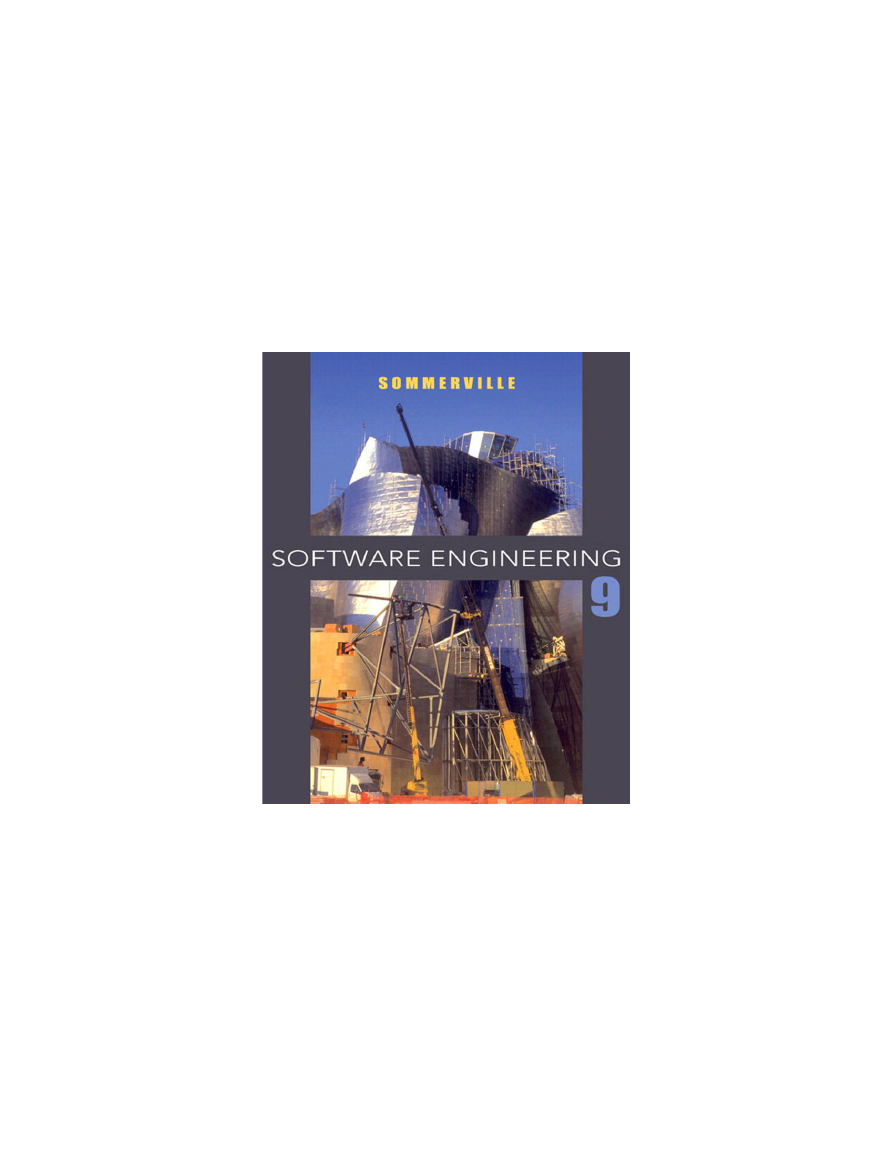
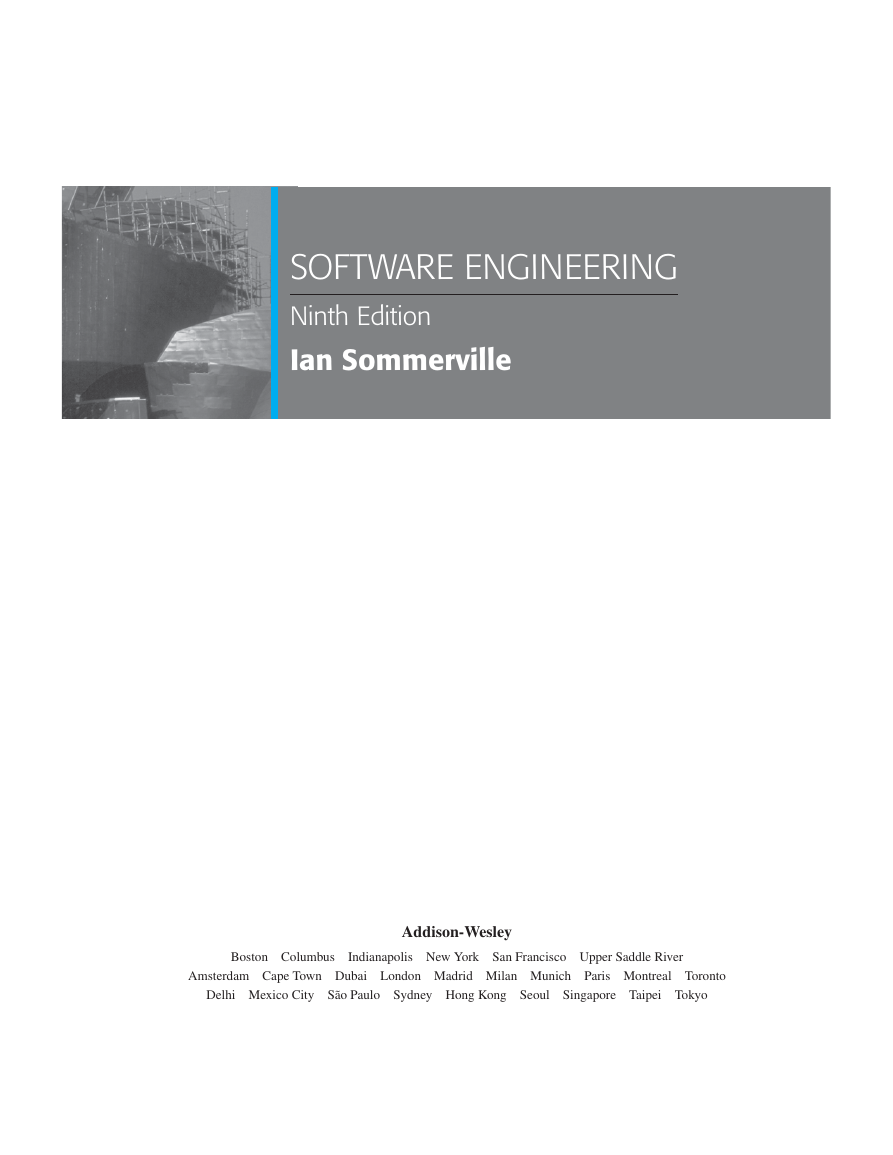
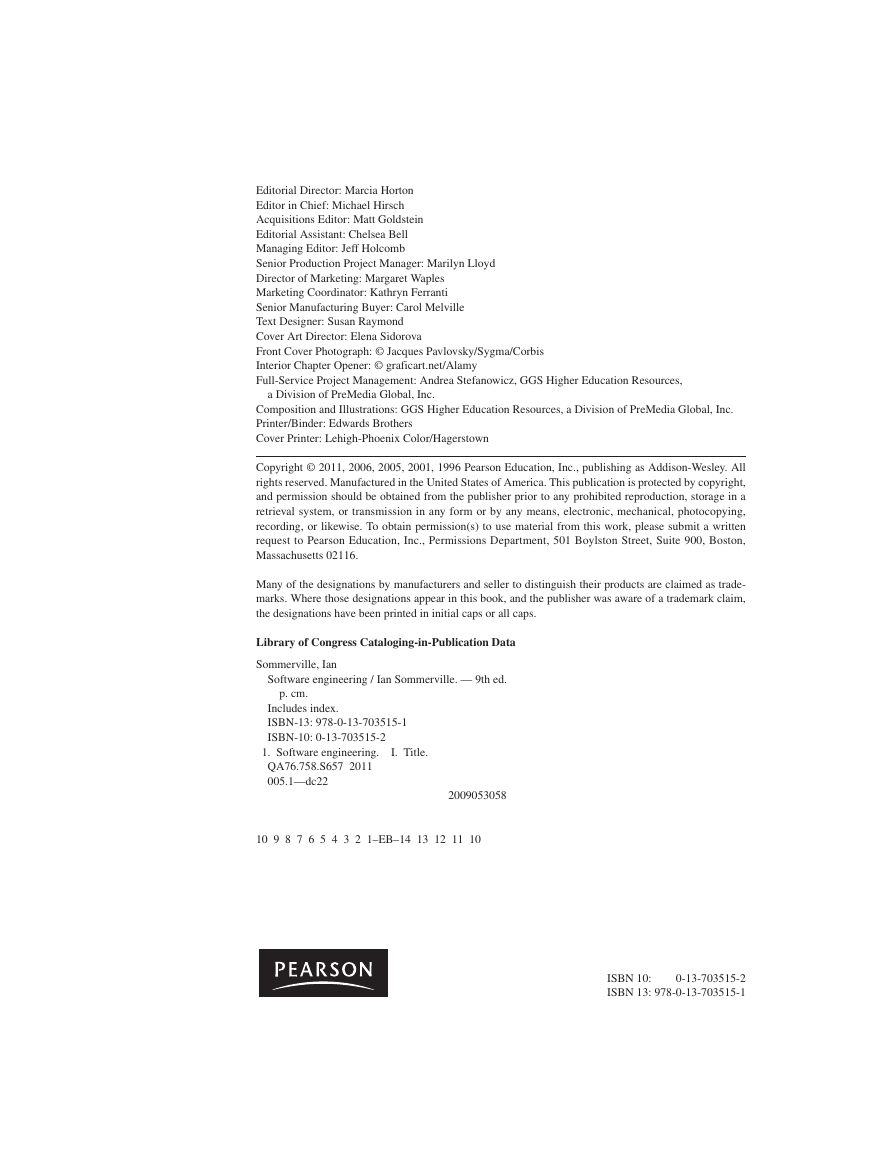
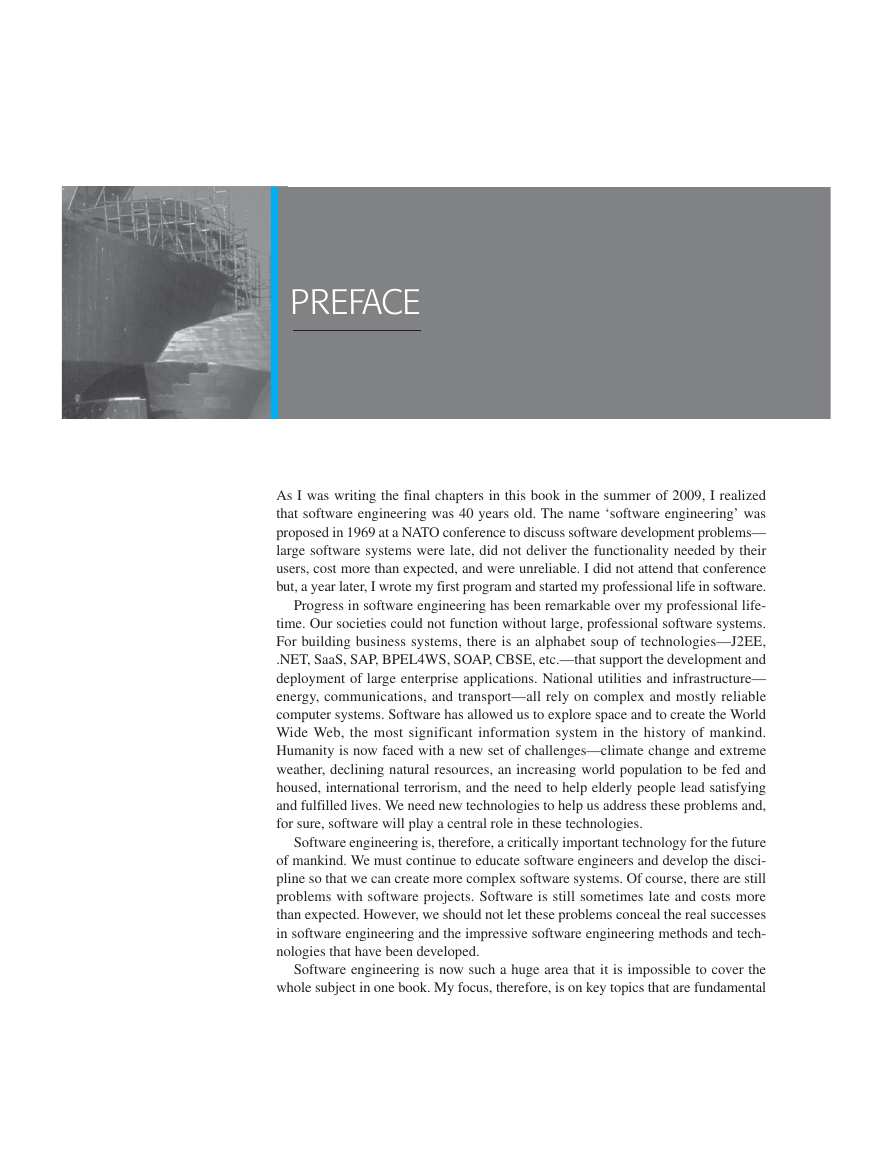
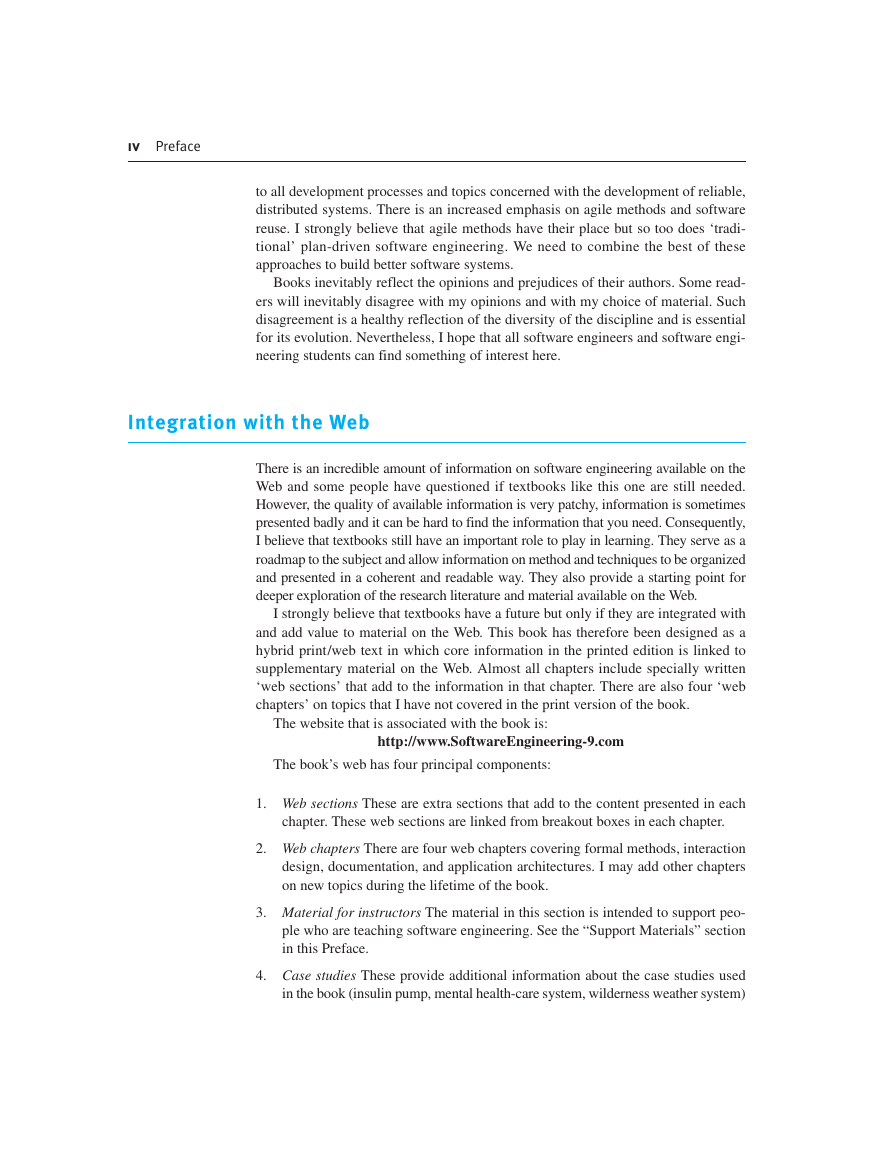
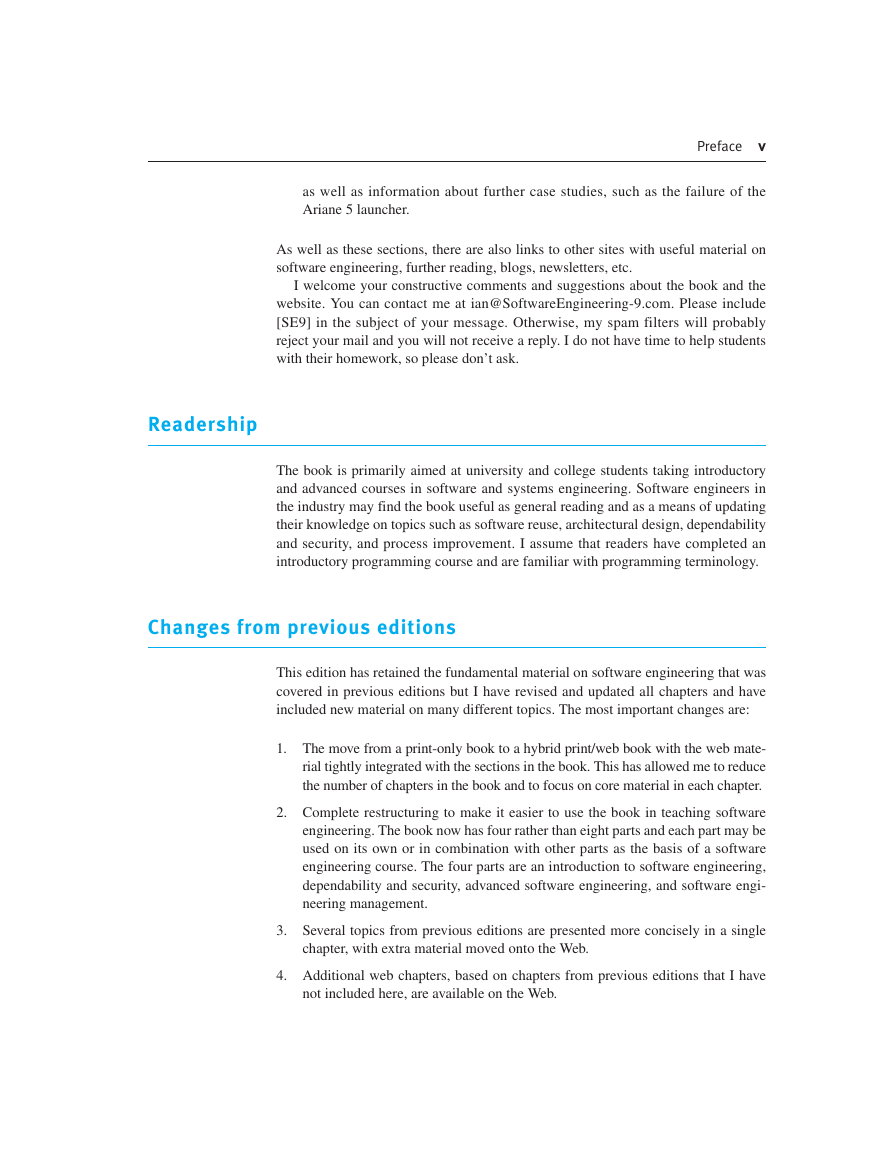
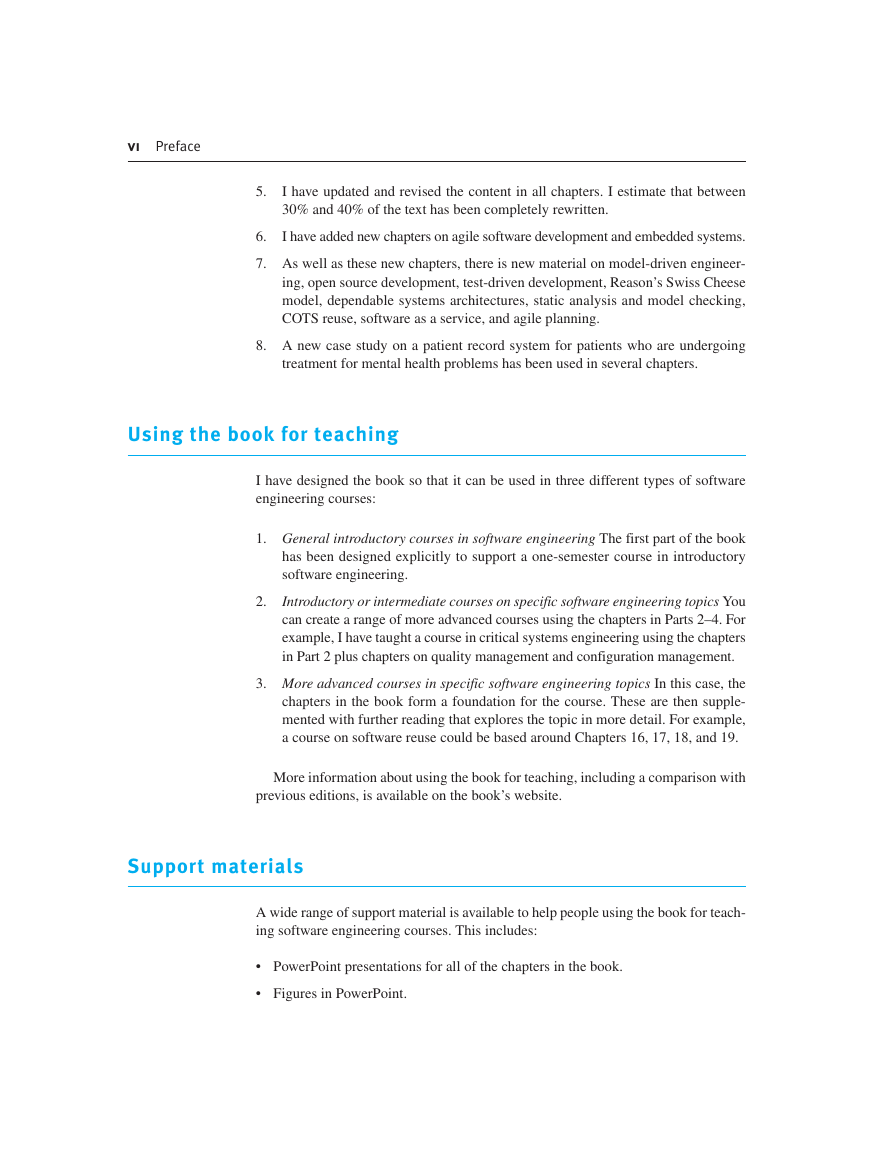
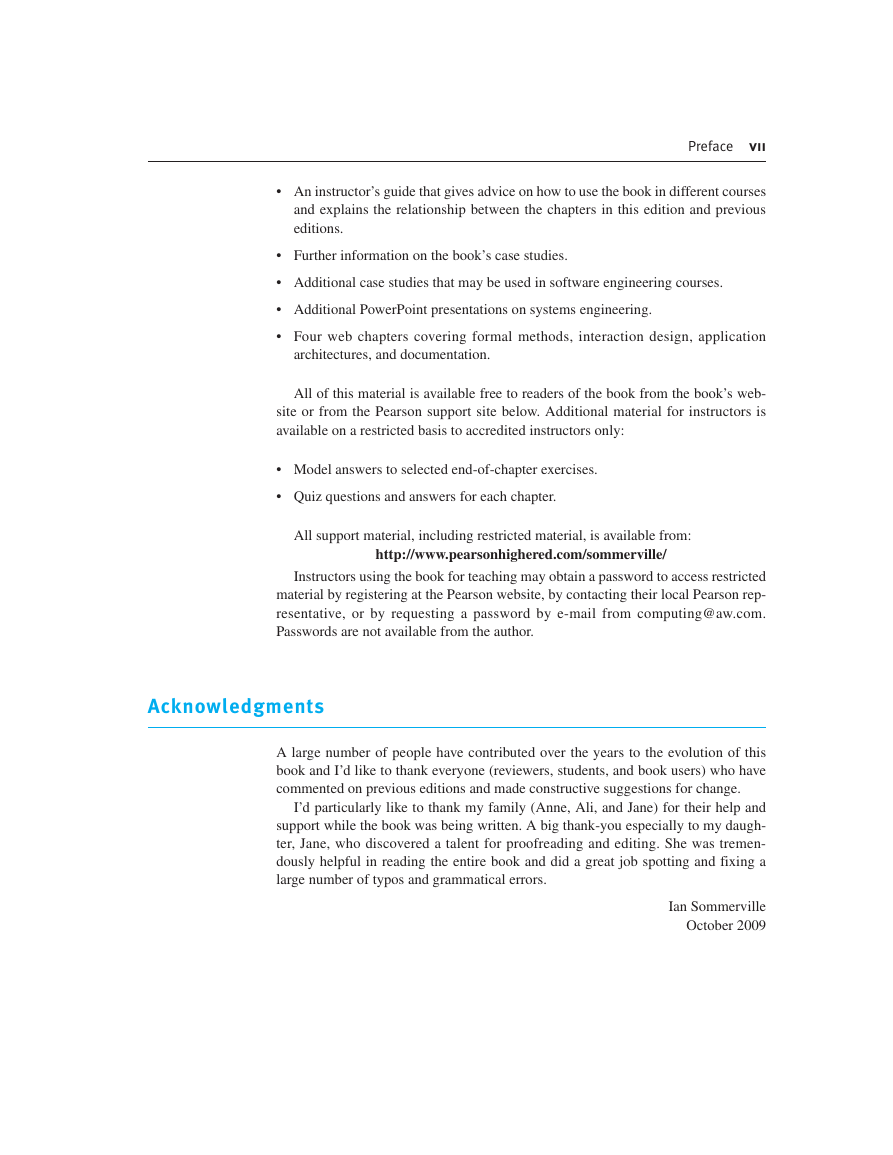








 2023年江西萍乡中考道德与法治真题及答案.doc
2023年江西萍乡中考道德与法治真题及答案.doc 2012年重庆南川中考生物真题及答案.doc
2012年重庆南川中考生物真题及答案.doc 2013年江西师范大学地理学综合及文艺理论基础考研真题.doc
2013年江西师范大学地理学综合及文艺理论基础考研真题.doc 2020年四川甘孜小升初语文真题及答案I卷.doc
2020年四川甘孜小升初语文真题及答案I卷.doc 2020年注册岩土工程师专业基础考试真题及答案.doc
2020年注册岩土工程师专业基础考试真题及答案.doc 2023-2024学年福建省厦门市九年级上学期数学月考试题及答案.doc
2023-2024学年福建省厦门市九年级上学期数学月考试题及答案.doc 2021-2022学年辽宁省沈阳市大东区九年级上学期语文期末试题及答案.doc
2021-2022学年辽宁省沈阳市大东区九年级上学期语文期末试题及答案.doc 2022-2023学年北京东城区初三第一学期物理期末试卷及答案.doc
2022-2023学年北京东城区初三第一学期物理期末试卷及答案.doc 2018上半年江西教师资格初中地理学科知识与教学能力真题及答案.doc
2018上半年江西教师资格初中地理学科知识与教学能力真题及答案.doc 2012年河北国家公务员申论考试真题及答案-省级.doc
2012年河北国家公务员申论考试真题及答案-省级.doc 2020-2021学年江苏省扬州市江都区邵樊片九年级上学期数学第一次质量检测试题及答案.doc
2020-2021学年江苏省扬州市江都区邵樊片九年级上学期数学第一次质量检测试题及答案.doc 2022下半年黑龙江教师资格证中学综合素质真题及答案.doc
2022下半年黑龙江教师资格证中学综合素质真题及答案.doc